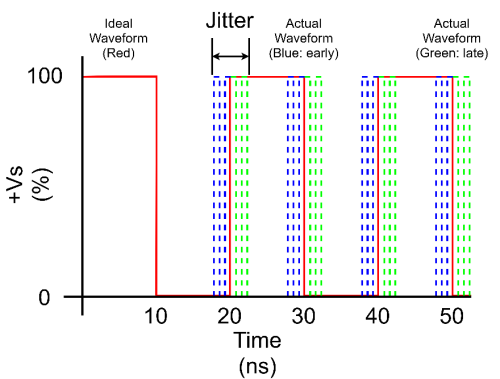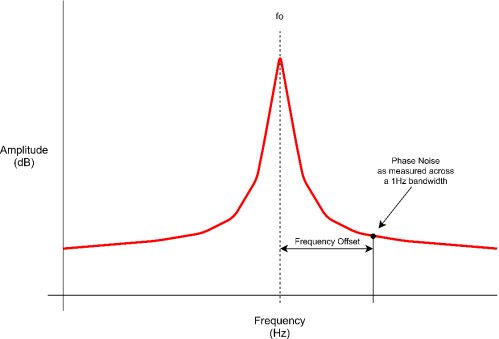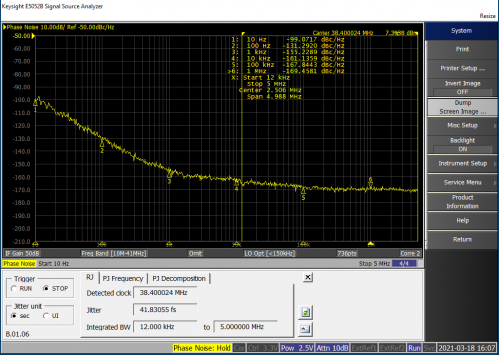What You Need to Know about Phase Noise and Jitter
Posted: 1st July 2021
In an ideal world, an oscillator’s output waveform would only be at one specific and exact frequency and also be stable with regards to time; however all oscillator output signals also include ‘noise’ whether that is in the form of fluctuations in frequency, time or amplitude. Therefore, we need some metrics to measure and make sense of these imperfections. That is where jitter and phase noise come in. So what exactly is jitter and phase noise and why should it be taken into consideration for applications?
What is Jitter?
Variations in the frequency domain are referred to as "phase noise" and variations in the time domain as "jitter". For this, consider a signal with two states, ‘on’ or ‘off’; this signal would ideally have a constant time period between the pulses, and all the pulses would be of equal lengths, and it would be easy to predict when the next pulse arrives.
However, if the signal is corrupted by ‘noise’, be it from within the device or via an external influence, this can cause the pulse to arrive early or late (Figure 1). This is essentially jitter and can be problematic by causing system performance degradation.
There are different types of jitter: period jitter, cycle to cycle jitter, phase jitter, and peak to peak jitter. At IQD, we mainly specify the phase jitter which is calculated from a phase noise plot.
It is important to note that all types of jitters describe the same phenomenon, but from a different point of view. This means that the values of different jitter types cannot simply be compared with each other.
For more information on the types of jitter read our application note Jitter and Phase Noise on our technical information page.

Figure 1 – Square wave plot showing jitter
What is Phase Noise?
Phase noise describes the noise spectrum that results from jitter in the signal frequency; as such, the two parameters are inherently related. The goal is to keep these fluctuations to a minimum; however, phase noise and jitter are unavoidable within a system and may negatively affect system performance.
In the diagram below (Figure 2), you can see the typical frequency spectrum of an oscillator’s output signal with respect to frequency and amplitude. The idealised dotted line at the carrier frequency (fo) shows the frequency of the oscillator. However, the red line on either side of the main response indicates other noise within the system.

Figure 2 – Signal plotted on spectrum analyser
For conventional phase noise plots we only show one sideband from the signal at ‘fo’, and the noise measurements are plotted logarithmically. For IQD’s typical phase noise diagram, please see Figure 3.

Figure 3 – Typical phase noise plot
The phase jitter is the area under the curve calculated across a specified bandwidth. The jitter calculation takes into account the carrier frequency and integration bandwidth and converts the frequency domain phase noise plot to a time domain phase jitter measurement.
Problems that occur with Phase Noise and Jitter
Low jitter and phase noise can be an important consideration in a number of applications such as high-speed data processing and transmission, ADC-DAC conversion or radar. However, engineers can face challenges resulting in signal degradation and data loss.
For example, a system that transmits data using a high-speed clock source would find that if the jitter were too excessive then adjacent signals could interfere with each other, resulting in signal degradation and data loss, often known as Bit Error Rate (BER).
In a radar system that emits an electromagnetic signal into the atmosphere, we need to look for the return echo, from a plane, for example. Jitter on the carrier signal translates directly to the position accuracy of the system, so jitter gives a fuzziness on the display.
If your application requires a specific phase jitter specification, this can be estimated from the phase noise profile. For example, if the application is for telecommunications or broadcasting, the product may have to meet a certain jitter specification.
IQD have recently launched a new tool to support customers, containing formulas to perform a quick calculation of phase jitter from a phase noise data set. This can be found on our technical information page named Jitter from Phase Noise Calculation.
For more information on phase noise and jitter for specific models or design queries, please contact our Applications Support team.
